Segment on Seven Melbourne, citing the research we did for the Herald Sun on mortgage stress by post code and sensitivity to rising interest rates.
Tag: Mortgage Stress
Nine News Does Mortgage Stress
Segment on Nine News which incorporates latest research from our mortgage stress modelling as well as research from finder.com.
Latest On Victorian Mortgage Stress
Today’s coverage in the Herald Sun looking at sensitivity analysis of mortgage stress in Victorian households received significant attention. Several tv news programmes tonight will continue the coverage.
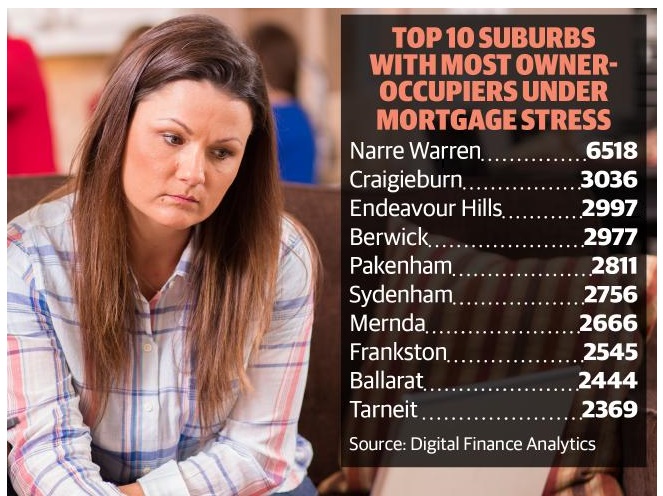 Here is a summary of the current levels of mortgage stress – around 300,000 households are feeling the pain of higher mortgage rates, flat incomes and rising costs of living. Not a good formula.
Here is a summary of the current levels of mortgage stress – around 300,000 households are feeling the pain of higher mortgage rates, flat incomes and rising costs of living. Not a good formula.
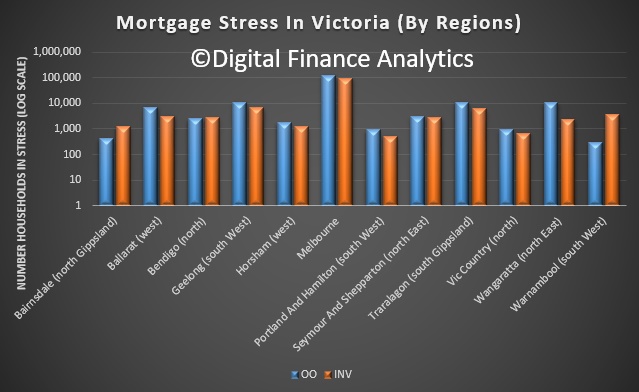 As well as those in the mortgage belt, some in the more affluent areas are also in difficulty. We modelled the impact of a 2% rate rise – the number of households in pain would double.
As well as those in the mortgage belt, some in the more affluent areas are also in difficulty. We modelled the impact of a 2% rate rise – the number of households in pain would double.
Note also that investment property holders are also under the gun, thanks to the recent rounds of mortgage repricing, despite flat rental yields.
This could get rather nasty. The best outcome would be a period of stagnant prices, the more likely is a correction as the chickens come home to roost!
More warnings about the Australian housing market
Australian house prices have continued their unprecedented ascent, with median home values in Sydney this week hitting a record $1.15 million and in Melbourne, $826,000, after rising by 13.1 percent and 7.6 percent respectively in the first three months of the year.
The frenzied growth of the east coast market has prompted a series of warnings pointing to the contradiction between inflated house prices and the stagnant or declining incomes of working people, amid a slump across manufacturing and other industries.
Last week, Moody’s cautioned that Australia’s housing market was among four in the world most susceptible to a crash in the event of an economic shock or a renewed downturn. The international ratings agency drew attention to the mountain of debt upon which the property bubble has been built, stating: “Australian households stand out for lower financial buffers and higher leverage.”
Moody’s drew a parallel between debt-to-liquid asset ratios in Australia, and in Ireland before the collapse of the property market in 2007. It commented: “[I]n the event of a negative income shock, the scope for Australian households to draw down parts of their financial assets to maintain debt service and overall spending is more limited than elsewhere.”
Deloitte Access Economics likewise pointed to the buildup of debt this week, noting that household debt to income ratios are the second highest in the world after Sweden. National household debt currently stands at 185 percent of annual disposable income, up from around 70 percent in the early 1990s.
Deloitte has estimated that house prices are around 30 percent overvalued compared to national income, the highest margin in over three decades. The firm’s director, Chris Richardson warned that in “global terms our housing prices are asking for trouble.”
In comments to the National Press Club last week, Richardson warned of the vast implications of any slowdown of the Chinese economy for the Australian housing market and financial system. He predicted that a sharp crisis in China could result in the collapse of house prices by around 9 percent, as part of a broader downturn that could destroy almost $1 trillion of national wealth.
Martin North, of Digital Finance Analytics, drew parallels with the US subprime mortgage crisis that played a key role in precipitating the global financial crisis of 2007–08. He listed declining incomes, rapidly rising household debt and a growth in mortgage stress as features in common.
North told Fairfax Media: “This falling real income scenario is the thing that people haven’t got their heads around.” National wage growth across the private sector was just 1.8 percent last year, the lowest level since records began in 1969. Modelling by North has indicated that 669,000 families, or 22 percent of borrowing households, are already in mortgage stress.
Other reports have pointed to the mounting social crisis caused by the ongoing rise in house prices, prompting warnings of a rise in mortgage arrears and defaults.
In its Financial Stability Review released last week, the Reserve Bank reported that around one third of mortgaged households have not built up any substantial repayment buffer, or are a month or less ahead of mortgage repayments. In other words, they are vulnerable to economic fluctuations and any change in their circumstances.
An ALI Group survey last month showed that 41 percent of homeowners feared that they would be unable to keep up with mortgage repayments if they lost their job.
This finding tallied with figures late last year from financial management software company Moneysoft, which found that more than 25 percent of non-investor home loans were “unhealthy.” Loans were deemed to be in bad health if they had grown by at least 5 percent over the course of the loan. Another 25 percent were termed “neutral,” meaning that they had neither grown nor substantially fallen.
The precarious situation of many has contributed to a growth in delinquent housing loans. They rose from 1.15 percent of all housing loans last December, to 1.29 percent in January, according to Standard and Poor’s. In some states the figure is far higher, with Western Australia, which has been hit by the collapse of the mining boom, registering 2.33 percent.
These conditions have led to intensified calls for the Reserve Bank to raise its official interest rate from a historic low of 1.5 percent, and take other measures to rein in speculative loans, including interest-only loans that do not require the borrower to pay off any of the principal for fixed periods of up to seven years.
Minutes from the central bank’s April meeting stated that it “would consider further measures if needed,” but did not spell them out. Any rise in interest rates, however, could lead to a rapid fall in borrowing, along with a rise in mortgage defaults, potentially provoking a dramatic contraction of the entire market.
The soaring cost of housing, which has made it unaffordable for many young people, has intensified the crisis of the Liberal-National government of Malcolm Turnbull. Like its Labor Party predecessor, the government has maintained capital gains tax concessions, and other policies, such as negative tax gearing, which have provided a boon for property developers.
Amid reported divisions within the government, various proposals have been floated, including allowing first homebuyers to access their superannuation funds to purchase a house and making limited reductions in the 50 percent capital gains tax concessions.
The Labor Party has demagogically denounced negative gearing tax incentives for investors. Their posturing was punctured by reports this week that federal Labor politicians own some 72 investment properties in total. Their Liberal-National and Greens colleagues likewise have substantial material interests in the ongoing housing boom.
None of the measures being discussed by the government, or any section of the political establishment, will resolve the housing affordability crisis and the massive growth of property market speculation that has fuelled it.
Loans to investors made up around 39 percent of all housing loans in January, with only 7 percent of loans for first homebuyers. The proportion of investors is higher in Sydney and Melbourne, the centres of the property boom.
According to the Australian Bureau of Statistics, investor loans grew by 27.5 percent on a seasonally adjusted basis, between January 2016 and 2017. The growth was well above the 10 percent annual limit placed on the banks by regulatory authorities.
The rise has coincided with an ongoing decline in productive investment. Corporate investment in new buildings, equipment and machinery fell in each quarter last year, with a decline of 2.1 percent in the December quarter alone.
As has happened around the world, the deepening crisis of global capitalism and the escalating slump in the real economy has seen the corporate elite turn to ever-more speculative financial operations. These do not produce real social wealth but inflate the value of existing assets, in this case, leading to a housing crisis for millions of working people.
Negative gearing exposing Australia’s poor: KPMG
KPMG warns any increase in Australia’s historically low interest rates would cause serious economic problems and affect households across the entire financial spectrum, from rich to poor.
The industry consultant said one of its biggest concerns is that Australian households have progressively increased debt levels at rates faster than their disposable incomes have grown.
Most notably, KPMG economists highlight some of Australia’s poorest citizens are taking on negatively geared property investments when there’s a clear inability to manage the financial risks.
Analysing the incomes and spending of Australian households over the past 20 years, KPMG said household income has primarily grown because of investment income and government transfers, not rising wages and salaries.
The firm added that more than one-third of the income of the poorest 20% of Australian households is received through government transfers.
Its report finds the bottom 20% of households recorded the highest rate of growth in investment income, at 8.5% per annum, compared to an average of 2.3% over the past decade for other households.
KPMG Australia chief economist Brendan Rynne said: “While it is perhaps understandable that the poorest members of our society want to diversify and increase their incomes, this group is the least able to take on the financial risk associated with geared investment activity.”
The second 20% of lowest-income households, or those slightly better-off, are getting relatively more than the lowest bracket in terms of (government) dollar transfers received per dollar tax paid. KPMG said this suggests policies to deliver welfare to the poorest members of society are less effective than to slightly better-off recipients.
“The proportion of households that end up paying no net tax – but via an administratively costly money-go-round of paying income tax and then getting it all or more sum back via income support payments, has now reached 60%,” Rynne said.
He says the answer is not further ratcheting up marginal tax rates for higher tax earners.
“Our analysis shows that the top 20% of households already pays 50% more income tax than the bottom 80% combined,” he said.
Tracing The Rise Of Mortgage Stress
We updated our mortgage stress models recently, which showed that around 669,000 households are in stress, which represents 21.8% of borrowing households. Those results are a point in time view of households finances. The RBA also said that one third of households have no mortgage buffer.
Today we take a longer term view of the rise of mortgage stress, which is driven by a combination of larger mortgages, flat incomes, higher living costs and rising debt.
The first chart tracks household debt to disposable income from the RBA, as well as mortgage rates, the cash rate and both CPI and wage growth.
Stress levels rose consistently through the early 2000’s as debt and mortgage rates rose, to reach a peak of 19%, when the cash rate was 7.25%, the average variable mortgage rate was 9.35% and the household debt to disposable income sat at around 170. Those with a long memory may remember that we were warning about this trend in the 2000’s.
But then the GFC hit, rates were cut, and mortgages rates fell sharply to 5.8%. However the debt to disposable income ratio only fell a little to 168.
Lower rates stoked demand for property, so prices started to rise, and mortgage rates moved higher, then lower as the RBA used housing to try to fill the gap left by the mining sector moving into the production phases. Household debt to disposable income has since moved higher to a new high of 189 and is still rising.
During more recent times, mortgage stress and household debt has been moving up – and the latest stress data shows an acceleration as income growth all but stalls, and costs of living keep going, mortgage rates are rising.
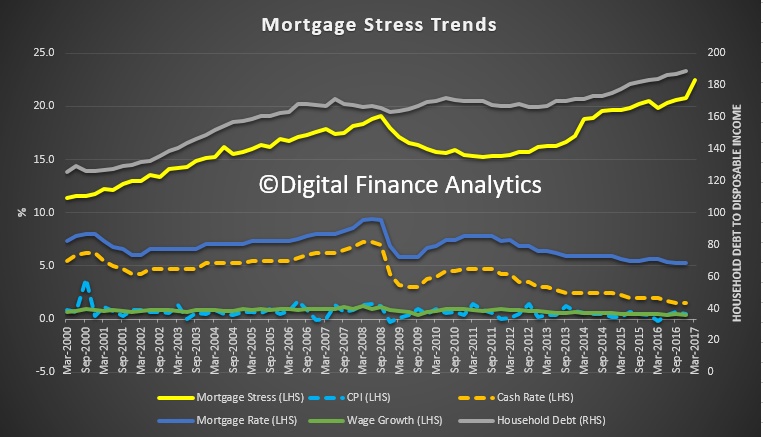 To look at this in more detail, here is the same data, but with CPI and wage growth now mapped to stress and the cash rate. The fall in wage growth is significant, and this has now become one of the main drivers of stress.
To look at this in more detail, here is the same data, but with CPI and wage growth now mapped to stress and the cash rate. The fall in wage growth is significant, and this has now become one of the main drivers of stress.
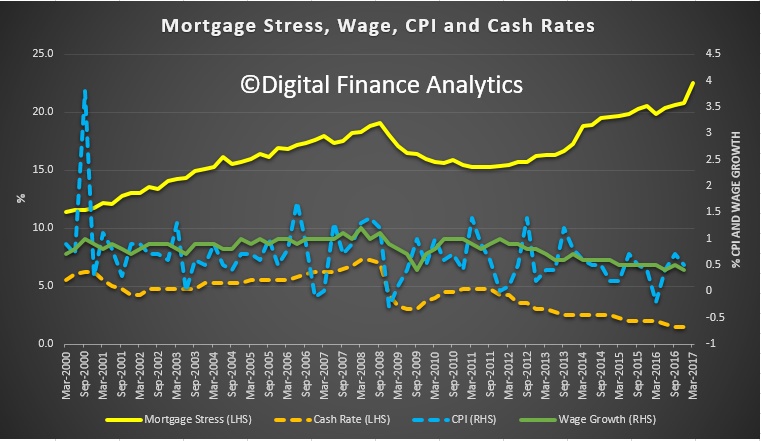 My point is, nothing has suddenly changed. The inexorable rise in household debt, especially in a low wage growth scenario was obviously going to lead to issues (see our posts from 3 years back!) and so the RBA’s apparent volte-face is a welcome paradigm shift, but late to the party. Perhaps the New Governor had a different perspective from the previous incumbant!
My point is, nothing has suddenly changed. The inexorable rise in household debt, especially in a low wage growth scenario was obviously going to lead to issues (see our posts from 3 years back!) and so the RBA’s apparent volte-face is a welcome paradigm shift, but late to the party. Perhaps the New Governor had a different perspective from the previous incumbant!
Of course the question now is, can this be managed without a property correction? Probably not. Read our definitive guide to mortgage stress here.
One final point. In the recent Financial Stability report, the RBA used HILDA data to argue that household financial stress was not too bad. But the data is not that recent, latest from 2014 and 2015, and since then our surveys highlight that some more affluent households are also being squeezed, especially as mortgage rates rise, and their incomes stall; they are highly leveraged.
The HILDA Survey also includes questions on financial stress experienced by households over the previous year. There was a broad-based decline in the share of households experiencing episodes of financial stress between 2001 and 2015 (the time span available in the HILDA Survey). Nonetheless, households that were highly indebted in a particular year had a greater
propensity to experience financial stress. For instance, households that were highly indebted in 2002 were more likely to experience at least one incidence of financial stress in all other years compared with households that were less indebted in 2002 (Graph C5, right panel). The result also holds true for other cohorts. This suggests that a greater share of highly indebted households face financial difficulties and are more likely to be vulnerable to events that affect their ability to repay their debt, such as income declines or increases in interest rates.Overall, these data highlight that highly indebted households can be more vulnerable to negative economic shocks and pose risks to financial stability. In particular, highly indebted households are less likely to be ahead of schedule on their mortgage repayments and they are more likely to experience financial stress, hence could be more vulnerable to adverse macroeconomic shocks. The consequent effects of this stress on the broader economy may be exacerbated by the disproportionately large share of investor housing debt owed by highly indebted households. Hightened investor demand can contribute to the amplification of the cycles in borrowing and housing prices, particularly when this investment is highly leveraged. Nonetheless, HILDA data also show that much of the debt held by highly indebted households is owed by households with high income and wealth, who are typically better placed to service larger amounts of debt.
Getting To Grips With Mortgage Stress
We recently released the latest data on mortgage stress. We said “of the 3.1 million mortgaged households, latest results from the DFA surveys of 52,000 households reveals an estimated 669,000 are now experiencing mortgage stress. This is a 1.5% rise from the previous month and maintains the trends we have observed in the past 12 months”.
Within our household data we have information on the drivers of mortgage stress, the symptoms of stress and how households are mitigating mortgage stress. Today we explore this data.
As described in our earlier post, we look for a range of leading indicators which signal mortgage stress, as well as comparing disposable income with outgoings. We do not use a “30% of gross income” measure because this is too general (there are some household not in stress with much higher proportions of income going on the mortgage, whilst others are paying lower proportions, but are in stress).
Mortgage stress is caused by a range of factors, including rising costs of living, flat incomes, underemployment, as well as unemployment, relationship breakdown and rising interest rates. There are some differences between those stressed and those in severe stress, but the portfolio of drivers are similar. Over time those stressed are more likely to turn into distressed, typically over 18-24 months.
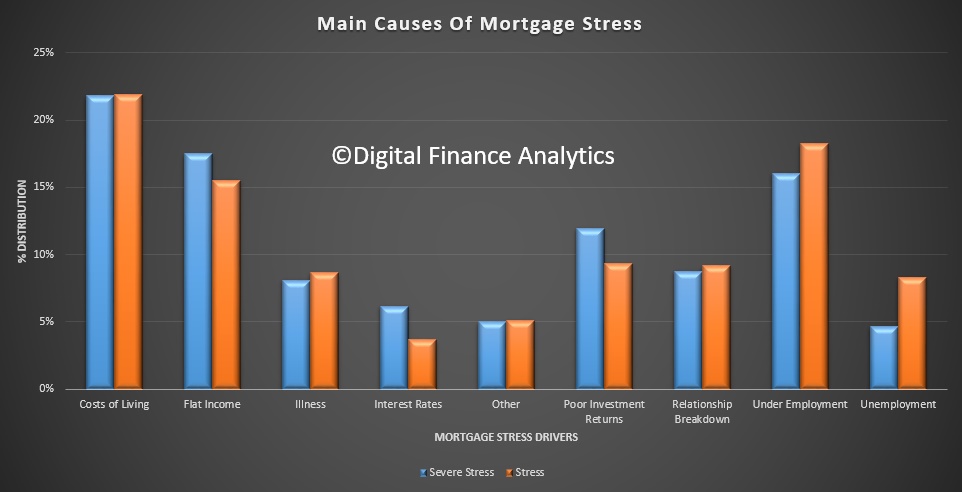 Here is a plot of the various behavioural mortgage stress drivers, separated by those in mild stress (stress) and those in severe stress. Those in stress are actively reviewing their spending priorities, looking at alternative mortgage repayment options to reduce outgoings, seeking to refinance, are putting more on credit cards and generally cutting back on spending; all to alleviate concerns about being able to meet mortgage repayments. Meantime they may well delay making payments.
Here is a plot of the various behavioural mortgage stress drivers, separated by those in mild stress (stress) and those in severe stress. Those in stress are actively reviewing their spending priorities, looking at alternative mortgage repayment options to reduce outgoings, seeking to refinance, are putting more on credit cards and generally cutting back on spending; all to alleviate concerns about being able to meet mortgage repayments. Meantime they may well delay making payments.
Severely stressed households are more likely to already be behind with their repayments, are seeking to sell, seeking hardship assistance, may already be involved in foreclosure, as well as the more normal activities of cutting back spending, re-prioritising, and putting more on cards.
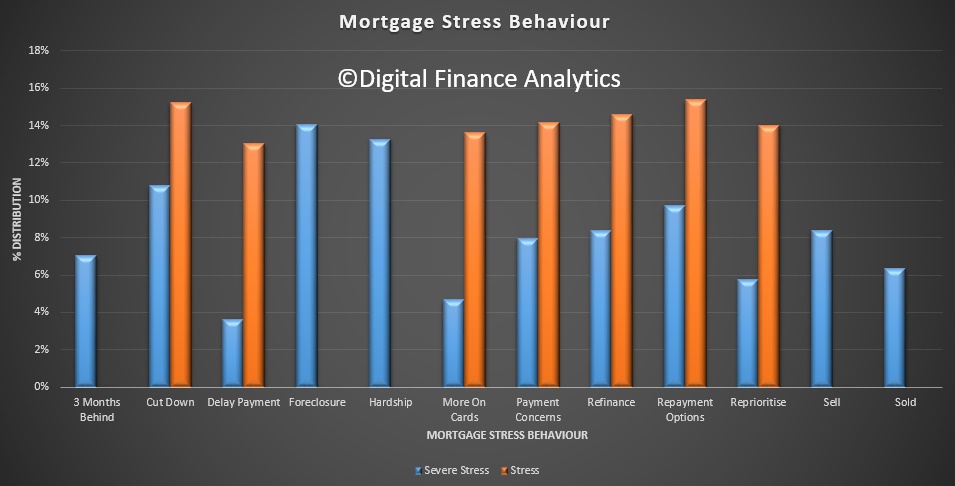 In terms of mitigation, those in mild stress are mainly using two strategies. First drawing on existing savings (which of course are finite) and second cutting back on other spending. Most do not expect to add to their credit cards as they are often already at their limit.
In terms of mitigation, those in mild stress are mainly using two strategies. First drawing on existing savings (which of course are finite) and second cutting back on other spending. Most do not expect to add to their credit cards as they are often already at their limit.
However, those in serve stress, whilst they will also do the same; a wider range of activities are on the cards, including seeking to sell or refinance, putting even more are cards (often getting additional credit), cancelling health insurance, and seeking help from friends, family and even unsecured loans (like pay day loans). This is again an indication of the complexity of the situation these households are facing.
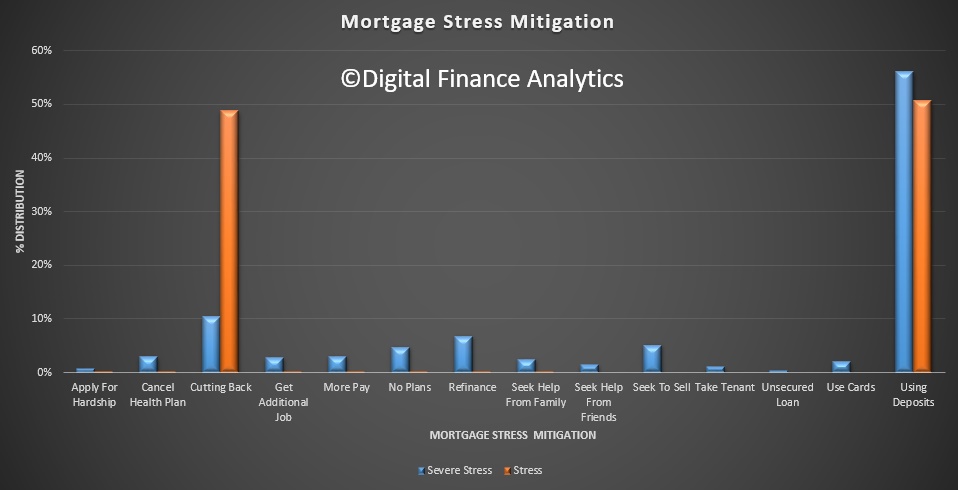 Dealing with mortgage stress is difficult, especially when incomes are static or falling in real terms and when interest rates are likely to rise further. Yet we note that about half of those we identify as in stress do not recognise they are in difficulty. The first step to solving a problem is to recognise you have one.
Dealing with mortgage stress is difficult, especially when incomes are static or falling in real terms and when interest rates are likely to rise further. Yet we note that about half of those we identify as in stress do not recognise they are in difficulty. The first step to solving a problem is to recognise you have one.
Many stressed households would benefit from some objective financial advice, as dealing with this is complex. There are not many independent sources of advice available. Whilst there is some information of ASIC’s Money Smart site, we think ASIC should put up more detailed guidance about spotting the symptoms and dealing with mortgage stress.
Many mortgage brokers and financial advisors would jump to selling more products, which is not the right solution in the majority of cases.
Malcolm Turnbull backs RBA warning as household debt hits new record
The Australian Financial Review covered the latest DFA mortgage stress research today, even if they managed to scramble the data in the chart I provided. Here is the correct data.
Household debt is rocketing towards 190 per cent of disposable incomes, ramping up pressure on the Reserve Bank of Australia and regulators to take action that avoids a US-style debt crisis.
Prime Minister Malcolm Turnbull endorsed Reserve Bank governor Philip Lowe’s warning that household debt is rising too fast and linked the high burden of servicing loans to the need for the Commonwealth to manage its debt.
A key reason for maintaining the government’s AAA credit rating is that credit agencies assume Canberra will bail out any banks that are blind-sided by a housing crisis.
“All of the warnings that the Reserve Bank and APRA have made about rising levels of debt are well made,” Mr Turnbull said in Sydney on Wednesday. “That’s their job, the system is working. They’re making changes and adjustments to the prudential rules that will take some of the heat out of the market, just at the right time.”
State household debt stress and default probability, Apr 2017
Galloping house prices in Sydney and Melbourne, as well as a surge in interest-only loans, have forced regulators into taking rearguard action against the potential financial risks that may unfold if the debt load becomes too heavy for households to bear.
A weak labour market and sluggish wages growth means the Reserve Bank is unable to raise the official cash rate to curb property market excesses for fear of crushing consumer spending, which accounts for the equivalent of about 60 per cent of the economy.
Figures published by the bank on Wednesday show the household-debt-to-disposable-income ratio is now sitting at about 189 per cent. The figure has accelerated in recent years after holding steady for much of the 2000s at about 160 per cent. A quarter-century ago the measure stood at about 60 per cent.
Research by consultants Digital Finance Analytics shows that of the nation’s 3.1 million households about 670,000 are unable to cover their living and interest rate costs, despite borrowing costs at historically modest levels.
The figures also challenge the Reserve Bank’s view that much of the debt is secure because it sits with high-income households, rather than the traditional “battler”.
Not the usual suspects
“The battlers are always close to the edge, but if you look at those in severe stress they’re more widely spread,” said Martin North, the firm’s principal.
“It’s the more affluent household groups, with big mortgages and lifestyle, now finding mortgage rates are rising when wages aren’t that are more exposed. They’re used to being profligate and they may not have as much in the bank as you’d expect.
“Not every affluent household is in difficulty, but it’s enough to make it interesting.”
Many heavily hocked households are increasingly facing a multi-directional squeeze with wages growth faltering just as many banks have already increased their mortgage rates by about 25 basis points in recent months. At the same time, costs bourne by many in the middle class are rising – for energy, school fees, childcare, medical and other expenses.
Even if the Reserve Bank does nothing, borrowing costs are almost certain to continue rising as banks are required by regulators to put more capital aside.
Impact would be severe
“We’ve brought forward all the housing consumption we can – that’s reflected in debt,” said IFM Investors chief economist Alex Joiner. “And that debt has accumulated rapidly, ahead of incomes.”
Credit growth continues to expand at about 6 per cent a year, while wages growth is less than 2 per cent, and household incomes are running at 3 per cent.
Unlike many other advanced economies that hit the wall after the 2008 global financial crisis, Australian households have never experienced a period of active de-leveraging, in which credit contracts at an annual rate.
Mr Joiner warns that the debt load means the Reserve Bank now has one of the world’s most “asymmetrical” monetary policy settings – in which even the smallest increase in the official cash rate will cascade heavily onto household cash flows.
“It’s come to a point where you think policy has been exhausted,” he said. “The Reserve Bank have been the stewards of the economy for too long and every time there’s been a setback we rely on monetary policy to fix it.
“I don’t think we can rely on that going forward.”
ABC The Drum Does Mortgage Stress
The Drum tonight discussed household finances and mortgage stress, based on our latest research.
Mortgage Stress Rises Again
The latest results from the Digital Finance Analytics mortgage stress modelling, released today, reveals another rise in the number of households experiencing mortgage stress.
Martin North, Principal of Digital Finance Analytics said “of the 3.1 million mortgaged households, latest results from the DFA surveys of 52,000 households reveals an estimated 669,000 are now experiencing mortgage stress. This is a 1.5% rise from the previous month and maintains the trends we have observed in the past 12 months. The rise can be traced to continued static incomes, rising costs of living, and more underemployment; whilst mortgage interest rates have risen thanks to out-of-cycle adjustments by the banks and bigger mortgages thanks to rising home prices. With the latest housing debt to income ratio at a record 188.7*, households will remain under pressure”.
Within the 669,000 households, which represents 21.8% of borrowing households, 20.8% are in mild stress, meaning they are managing to make their mortgage repayments by cutting back on other expenditure, putting more on credit cards and generally hunkering down. However, the remaining 1% of households are in severe stress, meaning they are behind with their repayments, are trying to refinance, or sell their property or seeking hardship assistance. Households are “stressed” when income does not cover ongoing costs, rather than identifying a set proportion of income, (such as 30%) going on the mortgage.
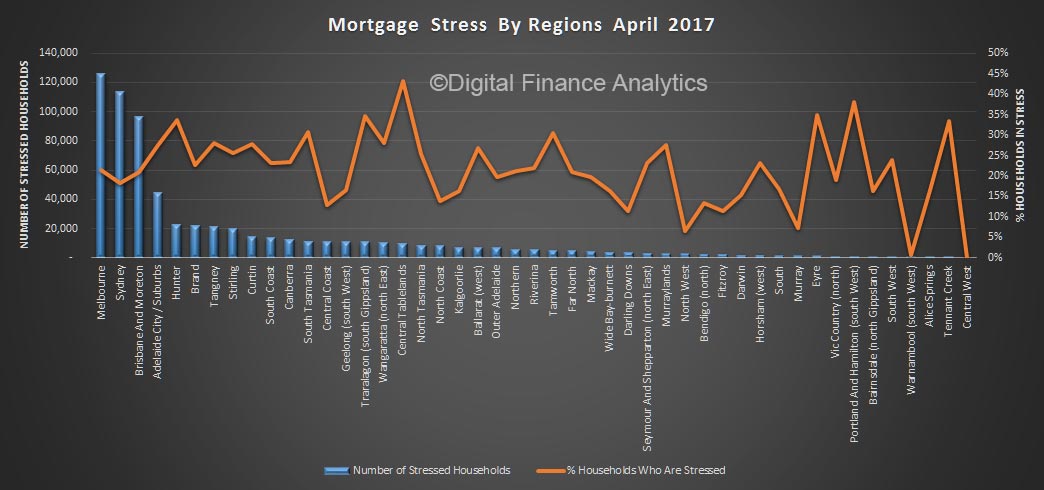 Regional analysis showed that 193,000 households are from NSW, 175,000 from VIC, 122,000 from QLD and 85,000 from WA. However, the largest relative proportion of households in stress are found in the smaller states of SA and TAS, where the impact of sustained low wage growth and underemployment is strongly felt.
Regional analysis showed that 193,000 households are from NSW, 175,000 from VIC, 122,000 from QLD and 85,000 from WA. However, the largest relative proportion of households in stress are found in the smaller states of SA and TAS, where the impact of sustained low wage growth and underemployment is strongly felt.
Looking ahead, the probability of 30-day mortgage default has also risen to 1.64%, with the highest risks residing in WA where it is more than 3% in the mining belts. “We expect mortgage stress rates to climb through 2017 as mortgage rate rise, whilst slow wage growth, and underemployment will continue to bite” concluded Martin North.
Detailed analysis shows mortgage stress continues to touch some more affluent households, who are highly leveraged, as well as the more traditional “battler” groups in the urban fringe. Younger families and recent first time buyers are under the most pressure.
*RBA E2 Household Finances – Selected Ratios Dec 2016

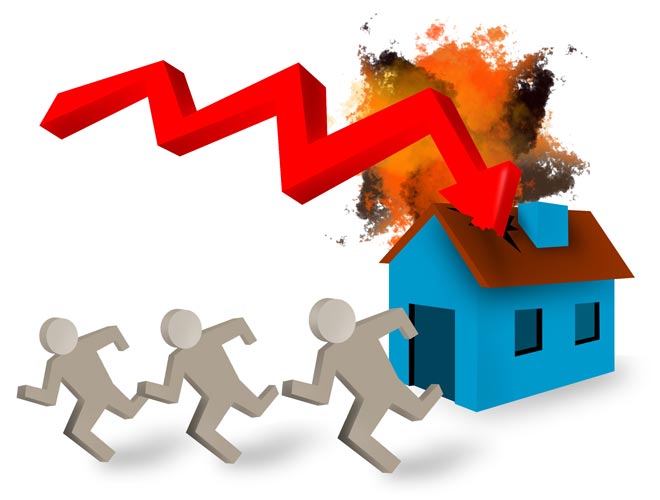
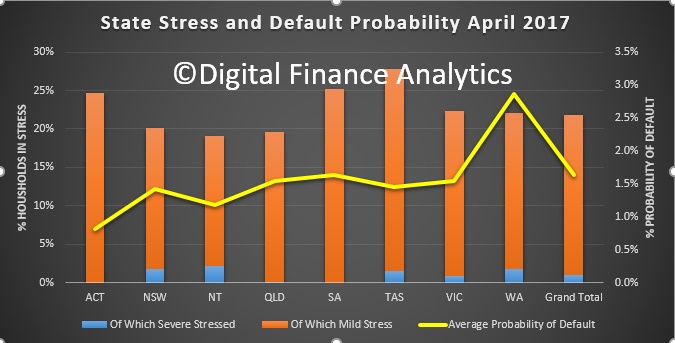
 State household debt stress and default probability, Apr 2017
State household debt stress and default probability, Apr 2017